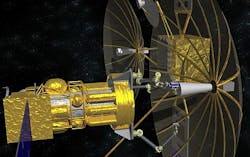DARPA to brief industry on expanded program to reuse parts from orbiting dead satellites
ARLINGTON, Va., 21 Jan. 2014. U.S. government researchers will brief industry 8 Feb. on enhancing future capability to reuse satellite antennas, apertures, and other components from decommissioned satellites in high-Earth orbit and build new satellites robotically in orbit to reduce the costs of replacing failed satellites.
Satellite experts at the U.S. Defense Advanced Research Projects Agency (DARPA) in Arlington, Va., will brief industry on the phoenix program, which seeks to develop technologies to harvest and re-use components from retired, cooperative, non-operating satellites in or near geosynchronous orbit (GEO).
Briefings will be from 8 a.m. to 2 p.m. on 8 Feb., 2013, at the DARPA Conference Center, 675 North Randolph St, in Arlington, Va. DARPA officials will discuss finding and sharing industry expertise that may be of value to the Phoenix program.
Phoenix seeks to reuse satellite components from decommissioned satellites parked in a graveyard orbit more than 22,000 miles above the Earth's surface to create new satellites at greatly reduced cost, DARPA officials say.
The idea is that building new satellites robotically in orbit using recycled components would be much less expensive than simply junking failed satellites, and building and launching new ones from scratch.
These satellites would operate in geosynchronous orbit, which matches the speed of the Earth's rotation and makes them operate in one spot above the planet's surface. Stationary orbits are extremely high, and repairing or retrieving failing spacecraft at these distances today is nearly impossible.
Government experts have established a graveyard, or disposal, orbit high above the Earth's surface where decommissioned spacecraft pose little risk of colliding with functioning satellites. The graveyard orbit is necessary because de-orbiting these high-altitude satellites is dangerous and expensive.
Until now, the graveyard orbit has been a celestial junkyard filled with decommissioned satellites of no use to anyone. Even tough they no longer function, however, these junked satellites often still have useful components like antennas and sensors.
DARPA officials want to launch orbiting robots that can salvage still-useful satellite components from the graveyard orbit and use them to build new satellites. Spacecraft in geosynchronous orbit are particularly useful for military and civil communications and persistent surveillance.
A previous DARPA solicitation requested industry proposals for satlets, a payload orbital delivery system (PODS) to orbit satlets quickly, and a separate on-orbit satellite servicing spacecraft with grasping mechanical arms and robotic tools to salvage spacecraft components and construct a new satellites.
An upcoming solicitation will seek to develop a rendezvous proximity operations (RPO) technology suite, synergistic number of degrees of freedom (N-DOF) test facility support, virtual ground station operations, and payload orbital delivery system launch.
Through the Phoenix program, DARPA seeks to hasten the creation and insertion of emerging technologies into on-orbit space system development at much lower cost while pioneering space-to-space interactions in geosynchronous orbit.
Those interested in attending the DARPA Phoenix industry briefings must register no later than 4 Feb. 2013 online at www.xpdanalytics.com/registrations/darpa/phoenix/proposers-day. Attendance is free, and those attending must show government-issued photo ID.
For questions or concerns contact Janine Bruhn, Erin Fowler, or Brook Sullivan by e-mail at [email protected].
More information is online at https://www.fbo.gov/spg/ODA/DARPA/CMO/DARPA-SN-13-16/listing.html.
